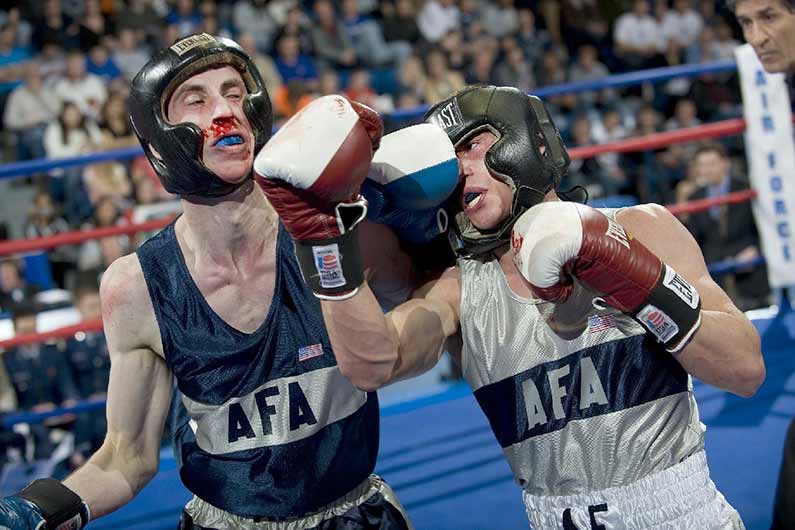Before you jump into the ring, it is essential to know what boxing punches are and how they work. The world of boxing can be confusing with so many different styles, stances, footwork and movements. This article will break down the 6 basic types of punches in boxing. It will also cover other common moves used by boxers such as evasive tactics and movement in all directions.
Want to join the MyFitnessFight community and get regular updates on our latest content? Tap the link to visit our homepage and sign up!
Disclaimer: This article was published for entertainment and educational purposes. It should not be used as personal or professional or medical advice. Please consult your doctor before deciding to engage in any new exercise activities or nutritional regimen. Take care!
What are the 6 punches in boxing?
While there are many ways to throw a punch, most attacks launched by trained boxers can be classified as one of six basic punches. These are:
- jab
- straight cross (often called just “straight” or just “cross”)
- lead hook
- rear hook
- lead uppercut
- rear uppercut
As you can see, it’s possible to further break these techniques down into 4 types of punches:
- jab
- straight cross
- hook
- uppercut
These punches can be thrown to targets on a boxing opponent’s head, face and body. Each attack has unique elements, advantages, and disadvantages that should influence how you use them.
If you want to learn boxing, understanding these punches and how they work is fundamental.

The 4 basic types of boxing punches
The jab
A jab is a quick, straight punch thrown with the lead hand. Jabs are fast but don’t pack much power – they’re often used to set up heavier punches or parry an opponent’s attack. However, a jab is also a formidable weapon in its own right and can be used to score points or knock opponents out.
Straight cross
A “straight” or “cross” is a powerful blow thrown with the rear hand. They’re often a boxer’s primary weapon and deliver knockout power when they connect on target.
Athletes who use straight crosses as their main strike should have an effective jab for setting up and defending against the rear hand.

Hook
A hook is an arcing punch thrown with the lead or rear hand. They’re good at catching an opponent off-guard and are often used as finishing blows to end fights. Hooks can also be used for scoring points by targeting opponents’ body such as kidneys, ribs, and solar plexus.
Uppercut
Uppercuts are powerful, rising blows thrown from a low position. They’re good for scoring points on an opponent’s head, and can end fights if they connect flush to the chin.

Boxing moves, footwork and evasion for beginners
Some casual observers never realize that boxing isn’t just about punching. In fact, some of the most famous boxers in history are more known for their footwork and evasive tactics.
A classic example of evasion winning a fight is Muhammad Ali’s 1974 victory over George Foreman.
Ali employed a tactic known as the “rope-a-dope”, remaining against the ropes and fighting defensively until Foreman exhausted himself chasing the knockout.
A more modern example is Floyd “Money” Mayweather. Often considered the best pound-for-pound boxer of all time, Mayweather is known for his slick footwork and evasive technique more than outright punching power.

How to move like a boxer – boxing footwork
A boxer’s primary concern should be protecting themselves at all times. While some athletes are able to win fights without employing a classic guard, there are few good reasons to drop your guard during a bout, especially as a beginner.
In order to maintain a standard one-foot-forward boxing stance, most boxers will use shuffle steps to move around the ring.
This involves sliding or quickly stepping one foot in the direction you wish to move, and then sliding or stepping the other foot towards the first to resume a proper stance.
Evasive tactics in boxing
Similar to throwing a punch, there are many ways to avoid a strike. While this is easiest to do when it involves moving your feet, staying in place and evading punches allows you to retaliate much more quickly.
The most logical and commonly used methods of in-place evasion can be broken down as follows:

Slip
You may have heard fighters or their trainers use the expression “slip and rip”, which is an evasive move followed by a punch. The “slip” in boxing is a swift side-to-side movement, most effective for evading straight punches.
You can slip to the outside or inside. A boxer who has perfected the slip can make their opponent look awkward by using minimal movement to evade powerful strikes.
Parry
The parry is a term taken from fencing, and refers to altering a blow’s trajectory before it can land. The parry is often used in combination with the slip as an extra layer of security.
For example, if someone throws a jab at you, you might slip to the outside. But just in case your timing is off, you could also parry the jab with a short jab of your own, or simply by adjusting your guard.
Roll
The roll in boxing refers to bending the knees (ducking) while shifting to the side. It’s a more aggressive form of evasion, and is usually used when an opponent throws several punches in close succession or as they’re throwing a heavy punch like a hook.
Clinch
Clinching refers to boxing moves that involve holding your opponents hands with one hand while punching them with the other hand (i.e. the clinch). It’s an example of boxing moves that can be used in close quarters, and is most often seen when two fighters are exchanging blows from a tight position.
Bob and Weave
The weave is similar to the roll – you’ll need to bend your knees as if you’re about to duck down and step forward with one foot while using the other to pivot.
You’ll then straighten your knees and step forwards with the opposite foot, ensuring you stay in an upright boxing stance while moving away from your opponent.
All of these are examples of how boxers can evade punches without dropping their guard or giving up ground – by using the entire body as a unit!
How to use a proper boxing stance
A boxer’s stance is one of the most important aspects of boxing. A typical stance has one foot forward with the body turned sideways and hands and forearms guarding the face.
Left foot forward is called an orthodox stance, whereas right foot forward is called a southpaw stance.
A good way to practice your boxing stance is to stand on a visible line on the floor. If your flooring doesn’t have any lines, you can always put down a strip of tape.
The ball of your front foot and the heel of your back foot should be more or less in line most of the time.
Boxers are also often told to “get low” or “get short”, meaning to bend their knees so that their head is below their opponents.
In addition to this, you should also tuck the chin and keep both hands up around eye level with your fists protecting your face as best you can.
How to breath in boxing
It’s important to stay calm and relaxed when boxing, but breathing is an often overlooked aspect of the sport.
Sometimes it feels natural for boxers to hold their breath while throwing a punch or defending themselves from one – this can lead to strain in your muscles and even cramping.
The best way to breathe is by taking deep breaths through the nose. It can also be helpful to exhale when throwing power shots.
Many boxers will exhale at least a little every time they punch, although if you are an especially high-volume puncher or throw a lot of jabs, this may not be practical.
Overall your breathing should be controlled and steady and follow the same rhythm as your moving body.
Conclusion – which boxing movements are most important for beginners?
The most important boxing movements for beginners are the basic punches, evasive maneuvers, and footwork. All of these can be practiced by most people with any fitness level on their own time.
In order to get started practicing your footwork you’ll want to find some kind of line like tape that’s visible on the floor – this will help you keep track of where your feet should go when facing different directions in a fight.
Even if you don’t have a punching bag, you can practice shadowboxing just about anywhere.
As long as you stay focused and consistent with your training, there is no doubt that mastering these simple techniques will make you a more efficient boxer and increase your chances against an opponent during competition.

